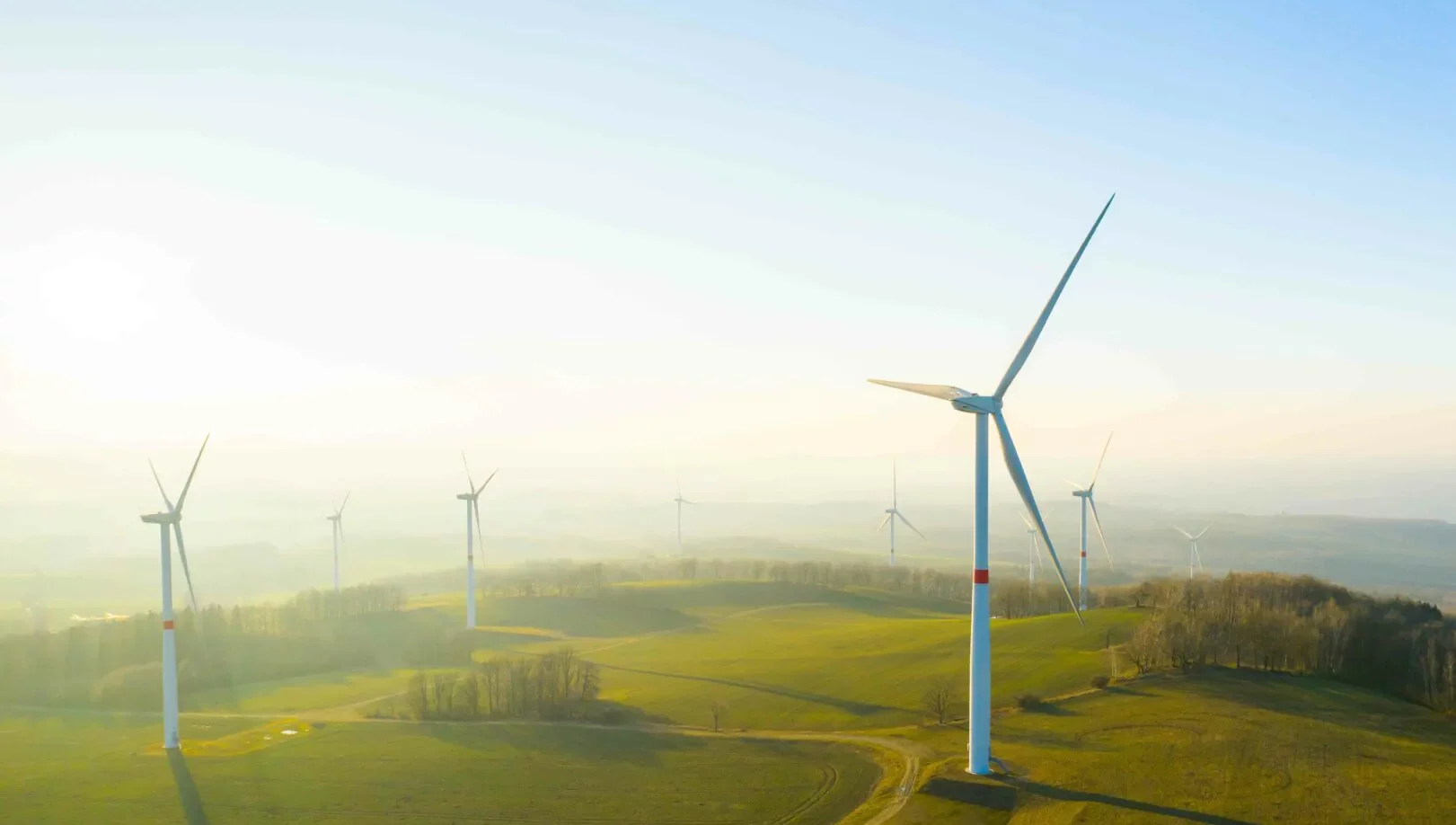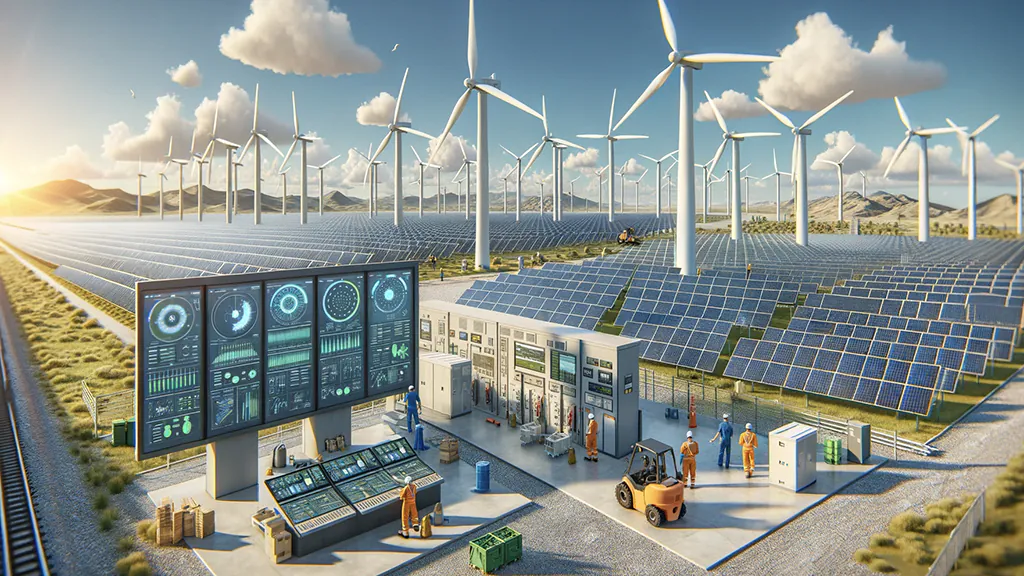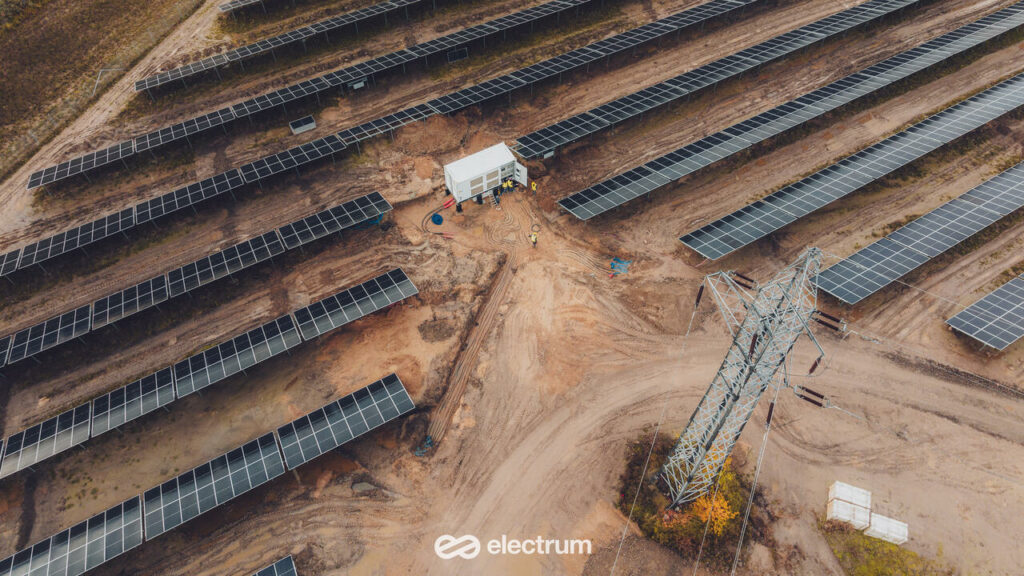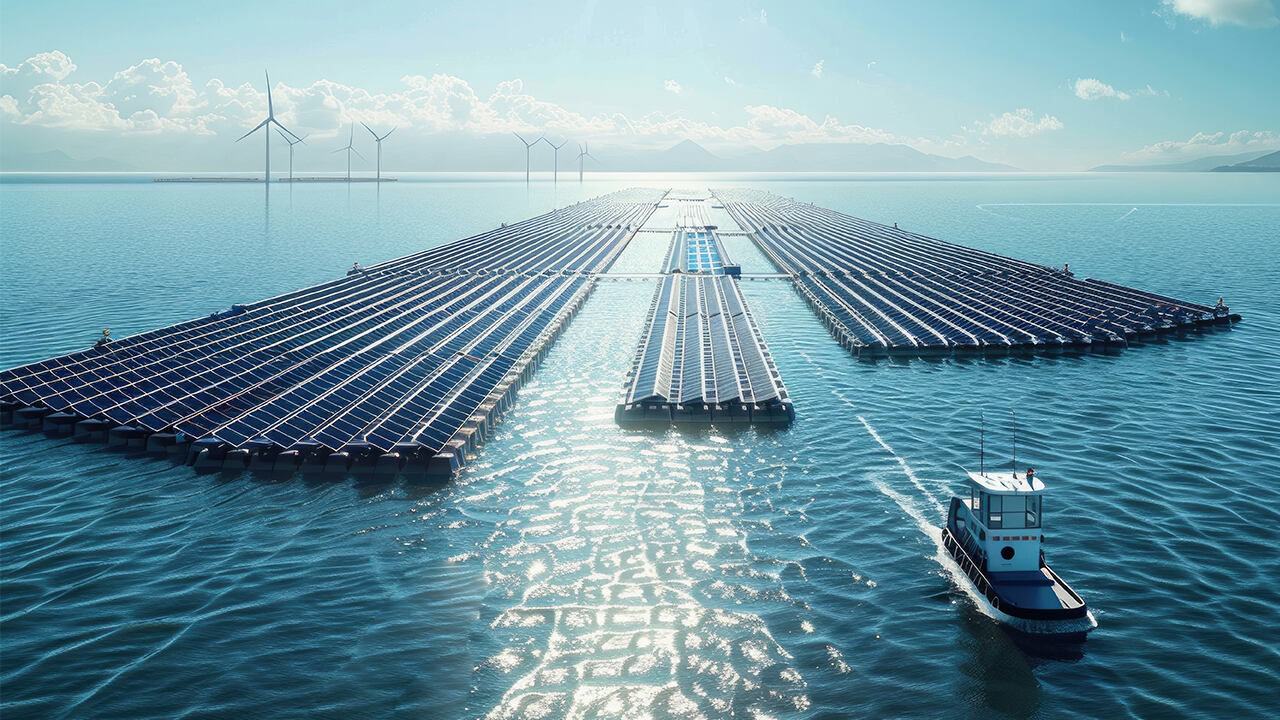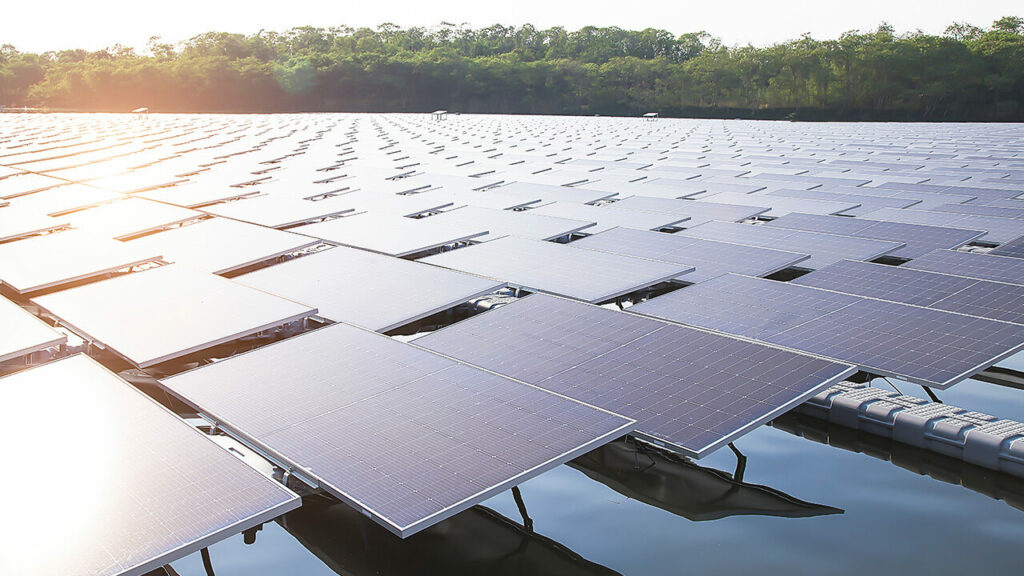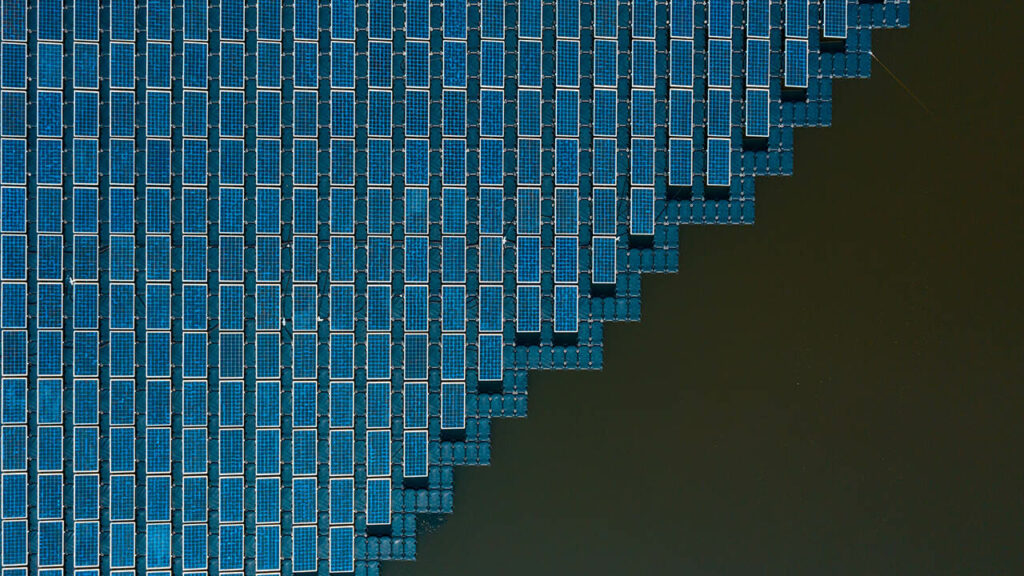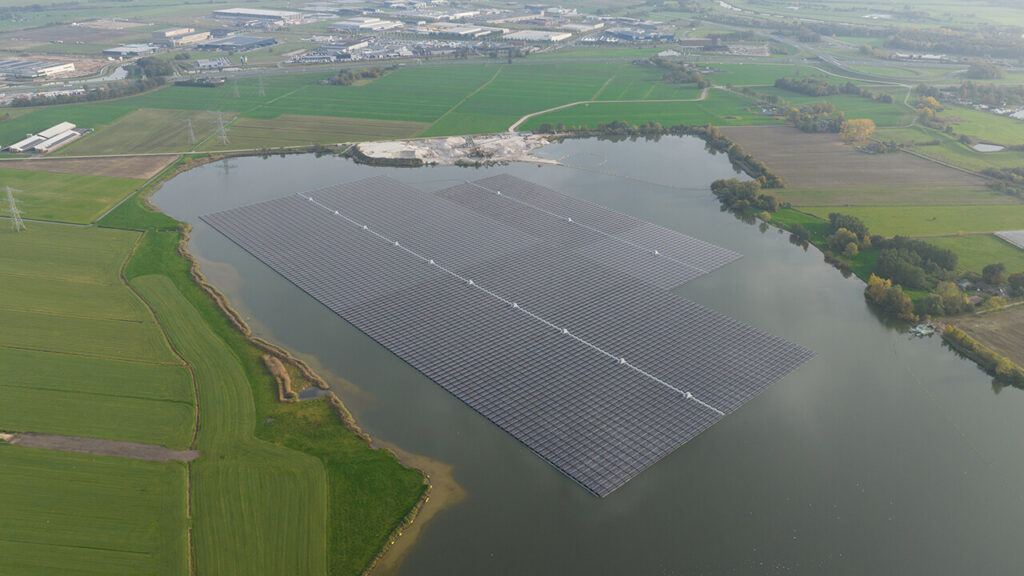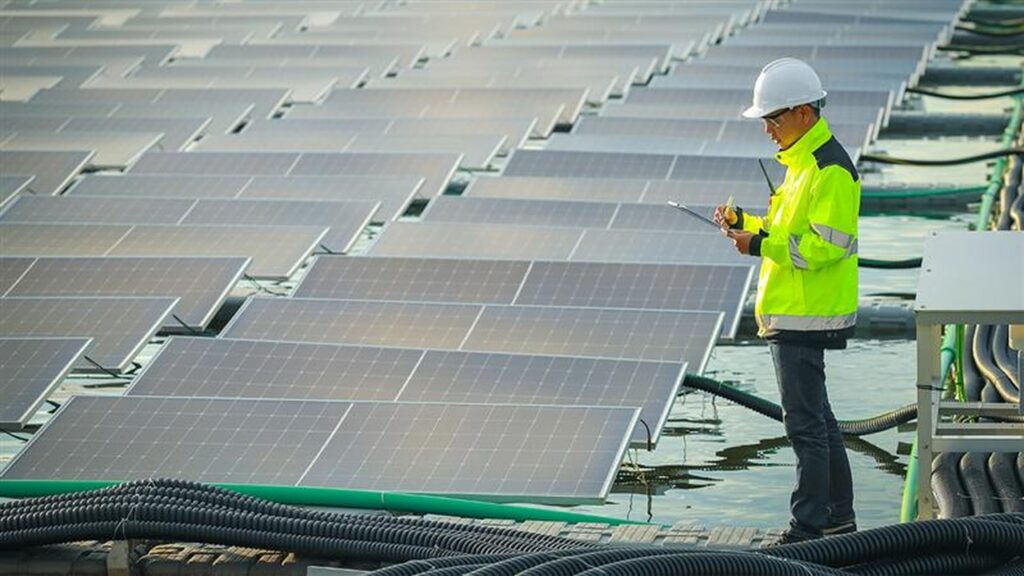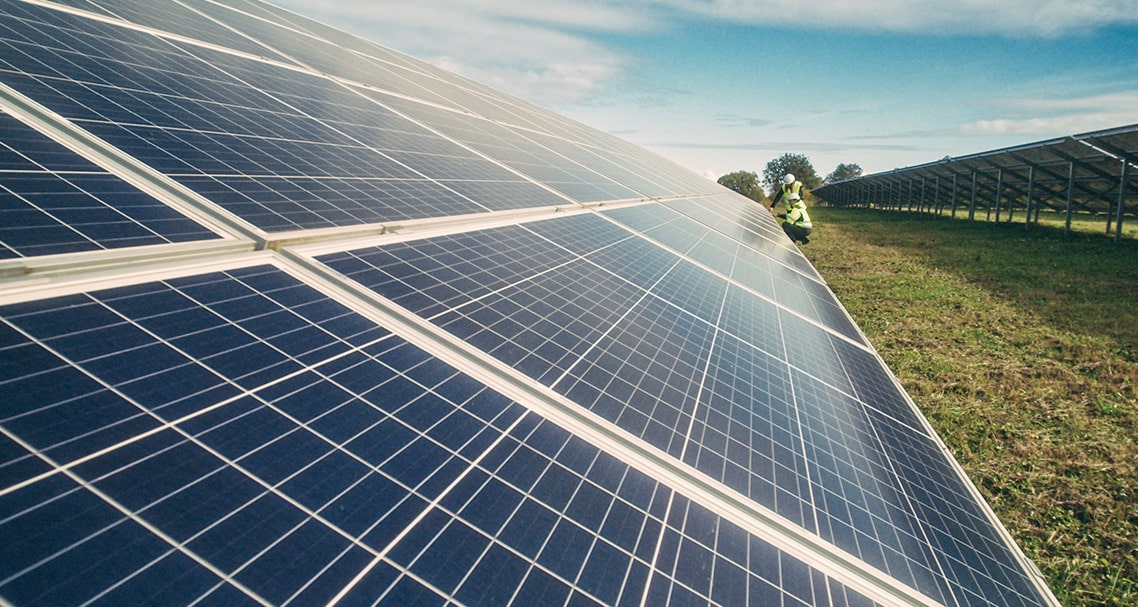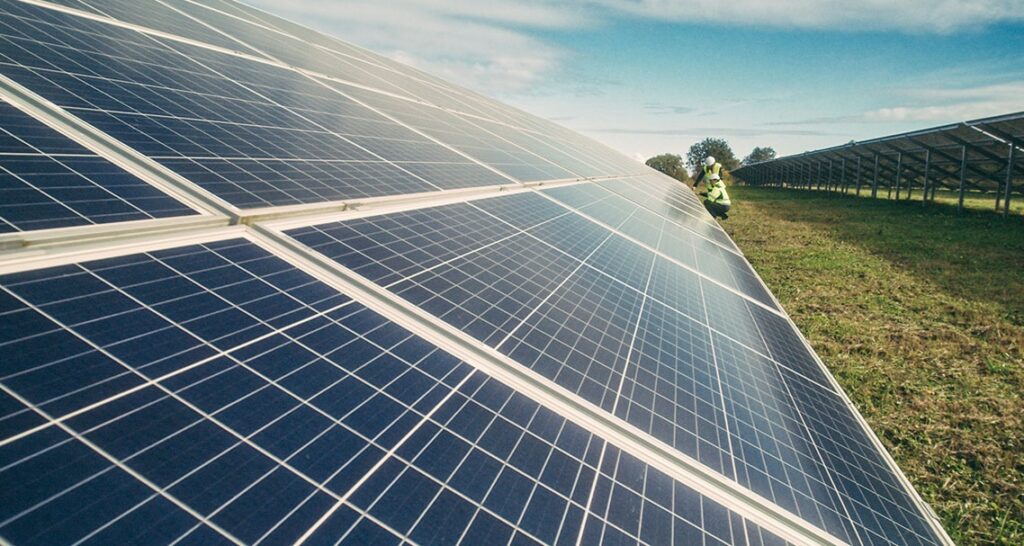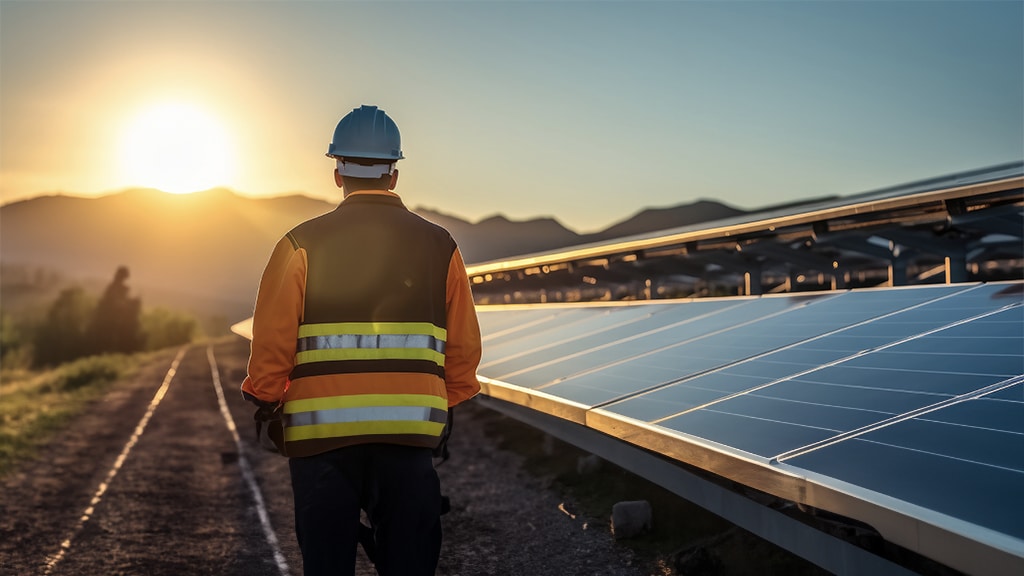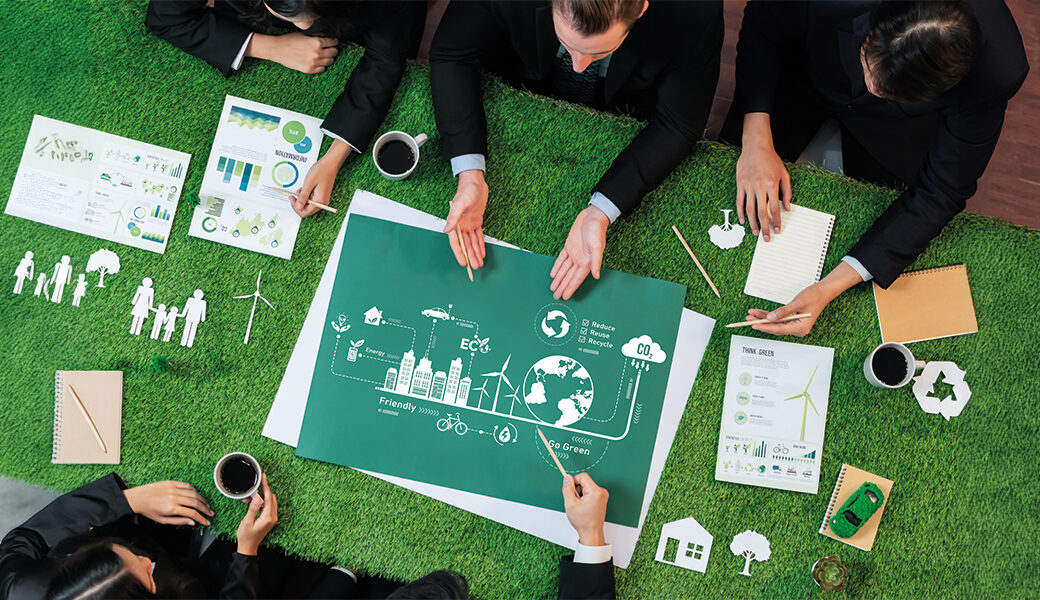Renewable Energy Sources (RES)
Renewable energy sources (RES) are those that do not cause long-term depletion when utilized, as these resources renew quickly. On a human time scale, they are sustainable and stable. They include, among others:
- Wind energy: the production of energy from wind using special turbines on land (onshore wind) or at sea (offshore wind).
- Solar energy: the generation of energy and heat from solar radiation using photovoltaic installations. Collectors produce thermal energy.
- Hydropower: the conversion of the force of flowing or falling water into kinetic energy using special hydraulic structures.
- Geothermal energy: the use of heat resources from beneath the Earth’s surface.
- Biomass energy: the conversion of biomass (e.g., from agricultural products, waste) into solid, liquid, or gaseous fuels.
Greenfield
In construction, a greenfield refers to investments on undeveloped land that does not have previous constraints from existing buildings or infrastructure. It’s like building on a “green field,” where there is no need to take into account existing structures.
Examples include new factories, power plants, and airports that are built from scratch on undeveloped land. In the transportation industry (e.g., cars, airplanes, engines), a comparable concept is “clean sheet design.”
Brownfield
In construction, a brownfield refers to investments on land that has already been developed or utilized. In the case of brownfields, there is already some infrastructure or buildings present on the site. Examples include the modernization of existing buildings, expansions, or renovations. In the chemical industry, modifications to an existing factory to increase efficiency are an example of a brownfield project.
Zoning Approval (Planning Permission)
Zoning approval is an administrative decision issued by the relevant municipal authority. It specifies the possibilities and restrictions regarding the development of a property. This decision includes information about the type of development, technical parameters, building height, roof design, number of floors, and guidelines for land use.
Zoning approvals for the solar farms construction may vary depending on the location and regulations in effect in a given municipality or region.
Nevertheless, here is some general information:
Solar Farms:
In the case of solar farms, the zoning regulations cover issues such as:
- Minimum distance from property boundaries.
- Angle of inclination of solar panels.
- Height of the supporting structures for the panels.
- Parameters of volumetric buildings.
- Maximum proportion of built-up area and minimum proportion of biologically active surface.
- Environmental impact (e.g., nature conservation, landscape).
- Safety and accessibility of the area for pv panel maintenance.
Remember that the exact requirements will depend on local regulations and project specifications. If you are planning to build a solar farm, it is advisable to consult with the local municipal office or a spatial planning specialist to obtain accurate information on this matter.
Local Spatial Development Plan
The Local Spatial Development Plan is a local law enacted by the city or municipality council. It regulates the use of land within a given municipality or city. The LSDP is valid only in the area that adopted it and defines the purpose and manner of land development. The LSDP document includes information regarding:
- Land Use Designations: Specifies how individual plots can be utilized.
- Principles of Space Protection and Shaping: Indicates how to maintain spatial and landscape order.
- Principles of Building Development: Includes aspects such as building height, building lines, and the dimensions of structures.
- Land Development Indicators: Defines development intensity, the proportion of biologically active surfaces, and other parameters.
- Restrictions on Land Use: This includes building prohibitions and special development conditions. The MPZP affects property value and shapes the future surroundings of the plots.
The Local Spatial Development Plan is crucial for the construction of photovoltaic farms. Here’s how it works:
- Local Plan: Photovoltaic farms can only be established based on the provisions of the MPZP. Previously, renewable energy installations could also be implemented based on zoning decisions, but now the MPZP is required.
- Areas for Renewable Energy Sources (RES): The municipality must designate areas for RES installations in the study of conditions and directions for spatial development. This means that the lands for photovoltaic farms are specified in the local plan.
- Implemented Changes: New regulations facilitate the development of photovoltaic power plants, but some fear that they may hinder the growth of large photovoltaic farms in Poland.
General Plan
The General Plan is a new spatial planning act that replaces the previous study of conditions and directions for spatial development in the municipality. It is a local law, meaning it has legal force in a specific area. This implies that it is binding for residents, entrepreneurs, and institutions operating in that location. In the context of construction, the General Plan governs land use at the municipal level.
The General Plan serves as the foundation for adopting more detailed local plans and for issuing zoning and land use decisions.
The General Plan must be adopted mandatorily for the entire municipality, and municipalities have until January 1, 2026, to adopt it. The provisions in the General Plan serve as the basis for adopting local plans and issuing zoning and land use decisions.
Building Permit Decision
A building permit is an administrative decision that is essential for starting and conducting construction or performing building works.
The building permit decision is an administrative decision issued by the appropriate architectural and construction administration authorities, such as county heads, voivodes, and the Chief Inspector of Building Supervision. This decision is issued after the relevant authority verifies the construction project, thereby approving it. It allows for the commencement and conduct of construction or performing building works other than the construction of a building structure. For this decision to become final, it must meet the requirements specified in the Code of Administrative Procedure. Additionally, before starting construction works, it is necessary to notify the building supervision authorities of the intention to commence these works within a specified timeframe.
Connection Conditions
Connection Conditions for the distribution network is a document that outlines the technical requirements that the connecting entity and the distribution network operator must meet in order to connect a facility to the network. The connection procedure begins with the submission of a CC application and is necessary to obtain the ability to use electricity in a given facility.
The Connection Conditions include, among other things:
- Detailed information regarding the location of the connection,
- Specification of the technical parameters of the connection,
- Requirements for measuring and protective devices,
- Technical conditions that must be met by the recipient’s installation.
This document is an integral part of the connection agreement and is valid for 2 years from the date of delivery to the applicant. If an agreement for connection is signed within this time, the validity of the connection conditions is extended for the duration of that agreement.
Learn more about this topic in our guide: Solar Interconnection | Grid connection requirements
Refusal to Specify Connection Conditions
A refusal to specify the Connection Conditions for connecting to the distribution network may occur in several cases, for example:
- When the planned construction site or installation is located in an area where there is no technical possibility to connect to the existing distribution network.
- If connecting the facility could jeopardize the safety or stability of the distribution network’s operation.
- In situations where the applicant does not meet the formal requirements specified in legal regulations, such as lacking necessary documents or submitting an incorrectly filled application.
- When the existing connection or network is overloaded and cannot accept additional load without expansion or modernization.
- If the implementation of the connection would require disproportionately high costs from the network operator that would not be covered by the applicant.
It is important to note that the refusal should always be thoroughly justified by the network operator, and the applicant has the right to appeal the decision to the appropriate energy regulatory authority. Additionally, the network operator should indicate what actions can be taken to possibly change the conditions and enable the connection.
Decision on Environmental Conditions
The Decision on Environmental Conditions, also known as an environmental decision, is a document issued by the appropriate public administration authority. It specifies the environmental conditions for the implementation of a project that may impact the environment or human health. This decision is essential for commencing investments that may significantly affect the environment.
The process of obtaining the decision on enviromantal conditions includes:
- Preparation of the application along with attachments, including the Information Card of the Project.
- Obtaining required opinions and agreements.
- Conducting an environmental impact assessment—if determined by the relevant authority.
- Preparing and submitting a report on the environmental impact of the project.
- Obtaining required opinions and agreements.
Obtaining the Decision on Environmental Conditions
This decision serves as the basis for issuing other administrative decisions, such as building permits or development conditions, and must be taken into account by the authorities issuing these decisions.
Transmission System Operator / Distribution System Operator
The Transmission System Operator is an energy company responsible for the transmission of electricity or gas fuels. Its responsibilities include:
- Managing network operations within the transmission system,
- Ensuring the current and long-term safety of the system’s operation,
- Operating, maintaining, repairing, and necessary expansion of the transmission network,
- Connecting with other gas or electricity systems.
In Poland, the role of transmission system operator is fulfilled by Polskie Sieci Elektroenergetyczne S.A. (PSE), which is responsible for ensuring the reliable operation of the transmission network and the supply of electricity to all regions of the country.
The Distribution System Operator is an energy company engaged in the distribution of electricity or gas fuels. The DSO is responsible for:
- Managing network operations within the distribution network,
- Ensuring current and long-term safety of network operations,
- Operating, maintaining, and repairing the distribution network,
- Planning and implementing necessary expansions of the network, including connections with other systems.
In Poland, the list of companies with DSO status is published by the Energy Regulatory Office (URE). Most electricity supply points are serviced by several main operators operating within larger energy groups.
Connection Conditions
A document issued by the Distribution System Operator or Transmission System Operator that specifies the technical and formal requirements related to connecting a new installation to the electricity grid.
Refusal to Specify Connection Conditions
A decision issued by the Distribution System Operator or Transmission System Operator, which indicates that the application for connecting a new installation to the electricity grid cannot be positively considered. Such a refusal may arise from various technical, economic, or formal reasons. Key factors may include a lack of technical possibilities, insufficient network capacity, non-compliance with spatial development plans, high connection costs, or failure to meet formal requirements.
Connection Fee
The cost incurred by the investor in connection with the connection of a new installation to the electricity grid. This fee is charged by the Distribution System Operator or the Transmission System Operator and covers the costs associated with the execution of necessary technical and administrative work.
Connection Advance Payment
The amount paid by the investor as a prepayment for future costs related to the connection of a new installation to the electricity grid. This is part of the total connection fee that the investor pays in advance to secure the execution of connection works by the Distribution System Operator or the Transmission System Operator. The connection advance payment is calculated at a rate of 30 PLN per 1 kW of connection power, with a maximum amount of 3,000,000 PLN gross.
Transmission Easement
A type of limited property right that allows a transmission enterprise (e.g., an operator of an electricity, gas, or water network) to use someone else’s property for the purpose of constructing, operating, maintaining, and servicing equipment used for the transmission of energy, gas, water, etc. This right is essential for ensuring the functioning of transmission infrastructure in a given area.
Tenant
A natural or legal person who, based on a lease agreement, obtains the right to use someone else’s property (or another object of the lease) in exchange for regular payments known as rent. The tenant may use the property in accordance with its intended purpose and the conditions specified in the lease agreement.
Read also: Leasing Land for Solar Farm: Essential Information
Lessor
A natural or legal person who, based on a lease agreement, grants their property (or another object of the lease) for the tenant’s use in exchange for regular payments known as rent. The lessor remains the owner of the property, retaining their ownership rights, while the tenant obtains the right to use it according to the terms of the agreement.
Basic Rent
A regular payment made by the tenant to the lessor under the lease agreement. The basic rent constitutes the main part of the compensation for the right to use the property and is specified in the lease agreement.
Initial Rent
A one-time or periodic payment made by the tenant to the lessor for the right to prepare the property for use or for the time during which the property is occupied but not yet fully utilized according to the intended purpose specified in the lease agreement.
Read more: Initial and Basic Rent in a Lease Agreement
Prosumer
A term combining the words “producer” and “consumer,” which refers to entities, most often households or small businesses, that simultaneously produce and consume electrical energy. A prosumer generates energy and uses it for their own needs, and any surplus energy can be fed back into the electricity grid.
Certificate of Origin (Green Certificate)
A document confirming that a specified amount of electricity has been produced from renewable sources. It is a tool used in many countries, including Poland, to support and promote the production of clean energy.
Net Metering
Net metering is a system for settling electricity that allows owners of micro photovoltaic installations to balance the amount of energy produced and consumed. In practice, this means that the surplus energy generated by the photovoltaic installation is sent to the power grid, and during periods when energy production is less than demand (e.g., at night), this surplus can be retrieved.
This system enables prosumers (producers and consumers of energy) to effectively manage their energy, thereby reducing electricity bills. In Poland, for every 1 kWh of energy fed into the grid, one can retrieve 0.8 kWh (for installations up to 10 kW) or 0.7 kWh (for installations from 10 to 50 kW).
Feed-in Tariff (FiT)
Feed-in Tariff (FiT) is a guaranteed tariff mechanism implemented by the government to accelerate investments in renewable energy sources. It involves offering long-term contracts to renewable energy producers, ensuring them fixed, guaranteed prices for the energy they generate. This stability allows producers to rely on steady income, which encourages investment in technologies such as solar, wind, and biomass energy.
FiT is particularly beneficial for small and medium-sized energy producers, as it enables them to sell energy at a fixed price that is typically higher than the market price. In Poland, this system covers installations with a total installed capacity of less than 500 kW.
The Feed-in Tariff (FiT) has both advantages and disadvantages. Here are a few of them:
Advantages:
- FiT provides fixed, guaranteed prices for generated energy, giving producers income certainty.
- With stable income, FiT encourages investment in renewable energy sources, contributing to sector growth.
- Promoting renewable energy sources helps reduce greenhouse gas emissions and air pollution.
- FiT supports the development of new technologies and innovations in the field of renewable energy.
Disadvantages:
- The costs associated with FiT can be passed on to consumers in the form of higher electricity bills.
- The high costs of subsidizing renewable energy may burden the state budget.
- FiT may lead to inequalities in the energy market, favoring renewable energy producers at the expense of traditional energy sources.
- FiT is dependent on government policy, meaning that changes in regulations can affect the stability of the system.
Cogeneration
Cogeneration, also known as Combined Heat and Power (CHP), involves the simultaneous production of electricity and heat in a single technological process. In traditional power plants, heat engines do not convert all thermal energy into electricity, resulting in significant heat losses. Cogeneration allows for the utilization of this heat, which would otherwise be wasted, thus increasing energy efficiency.
Advantages of Cogeneration:
- Cogeneration can be up to 70% more efficient than separate production of electricity and heat.
- Reduced fuel consumption leads to significant economic savings.
- Decreased emissions of CO₂ and other harmful substances.
Applications of Cogeneration:
- Industry: Factories, manufacturing plants.
- Public Utility Buildings: Hospitals, schools, office buildings.
- Municipal Sector: District heating plants, wastewater treatment facilities.
Types of Cogeneration:
- Systems that utilize exhaust heat from gas turbines, usually powered by natural gas.
- Competitive with gas turbines for capacities around 5 MW, also powered by natural gas.
- Systems that use biofuels, which reduces the consumption of hydrocarbon fuels and lowers CO₂ emissions.
Solar Farm (PV)
A solar farm (PV) is a specialized type of power plant that utilizes solar energy to produce electricity. It consists of numerous photovoltaic panels arranged over large areas of land or, in some cases, on water surfaces in the form of floating installations. These panels convert sunlight into electrical energy using semiconductors, typically made of silicon.
Photovoltaic farms can vary in size—from small local installations with a capacity of several kilowatts (kW) to large systems with capacities of several megawatts (MW), capable of powering thousands of households. They are a key component of global energy strategies, reducing reliance on fossil fuels and contributing to the reduction of greenhouse gas emissions.
WTG
The abbreviation WTG in the energy sector stands for Wind Turbine Generator. It is a device that converts the kinetic energy of the wind into electrical energy. A WTG consists of several key components:
- Rotor: Composed of blades that rotate due to the wind.
- Generator: Converts mechanical energy from the rotor into electrical energy.
- Tower: Supports the rotor and generator at an appropriate height to maximize wind speed utilization.
- Control System: Monitors and optimizes the turbine’s operation, ensuring its efficiency and safety.
WTGs are a crucial element of wind farms, which are one of the most important sources of renewable energy worldwide.
While WTG (Wind Turbine Generator) and a wind power plant are closely related, they are not the same. A WTG refers to a single wind turbine, whereas a wind power plant consists of multiple wind turbines located in one area that collectively produce electricity. Wind farms can be onshore or offshore and are often referred to as wind power stations.
To learn more, check out article: Wind turbine components and construction
Energy Storage System (ESS)
An Energy Storage System (ESS) is a technology that enables the storage of energy in various forms (e.g., electrical, thermal) for later use. Energy storage systems are crucial for stabilizing power grids, integrating renewable energy sources, and improving energy efficiency.
For further information, you can check resources on topics like Leasing Land for Solar Panels and Energy Storage – A Guide
Electrochemical Storage:
- Lithium-ion Batteries: The most commonly used in home energy storage systems and electric vehicles.
- Lead-acid Batteries: An older technology still used in some applications, such as emergency power supply.
Mechanical Storage:
- Pumped-storage Hydroelectricity: Water is pumped to a higher elevation reservoir and then released to generate electricity.
- Compressed Air Energy Storage (CAES): Energy is stored by compressing air, which is then released to drive turbines.
Thermal Storage:
- Heat Storage: Energy is stored in the form of heat, for example, in water tanks or phase change materials (PCMs).
- Cold Storage: Energy is stored in the form of cold, such as in ice or other cooling materials.
Kinetic Storage:
- Flywheels: Energy is stored in the form of kinetic energy in a rotating flywheel, which can quickly release energy when needed.
Also read: Energy Storage Site Selection: What Land is Suitable?
Hybrid renewable energy systems
In the context of energy, a hybrid installation is a system that combines various energy sources to provide more reliable and efficient power supply. Common configurations for hybrid systems include:
- Solar Energy (Photovoltaic Panels) combined with Wind Energy (Wind Turbines)
- Renewable Energy Sources (such as solar and wind) alongside Conventional Energy Sources (like diesel generators)
- Energy Storage Systems (like batteries) integrated with different energy sources to ensure continuous supply.
Hybrid installations are especially useful in areas where access to the electrical grid is limited or unstable. By combining different energy sources, these systems can offer more stable and reliable power while optimizing costs and minimizing environmental impact.
For more detailed insights into hybrid installations and their applications, you can explore the article:
Hybrid renewable energy systems – An Interview with Kamil Kozicki
Main Power Supply Point
The Main Power Supply Point (MPSP) is an electrical substation that plays a crucial role in the electricity distribution network. The MPSP serves as a hub where overhead lines of medium and high voltage converge. Its primary function is to ensure the supply and coordinate the flow of electricity within a designated area.
The MPSP provides electricity to cities and large industrial installations. It includes high voltage (HV) and medium voltage (MV) switchgear, as well as power transformers. This setup enables the processing and distribution of electrical energy at various voltage levels, ensuring stability and security of supply.
Main Receiving Point
The Main Receiving Point (MRP) is an unattended facility designed for receiving electricity from generation units, such as wind or photovoltaic farms, and feeding it into the electricity distribution system. Unlike the Main Power Supply Point, the MRP does not require constant supervision and is designed for automatic management of energy flow.
This automated system facilitates efficient integration of renewable energy sources into the grid, enhancing the stability and reliability of electricity supply without the need for manual intervention.
Connection Line
The connection line in energy projects is an infrastructure component that links the electricity distribution network to a specific facility, such as a home, office, or factory. It is a crucial element that enables the delivery of electrical energy to the building. The connection line consists of several components:
- Electrical connection: The physical link between the network and the building.
- Junction box: The location where the main fuses are situated.
- Distribution board: Divides energy into individual circuits within the building.
- Energy meter: Measures electricity consumption.
This system ensures that electricity is effectively routed from the grid to end-users, facilitating safe and efficient energy distribution.
Low Voltage (LV)
Low voltage (LV) refers to electrical voltage that does not exceed 1 kV (1000 volts) for alternating current or 1.5 kV (1500 volts) for direct current. It is commonly used in electrical installations in residential, commercial, and industrial buildings, powering applications such as lighting and household appliances (e.g., refrigerators, televisions).
Medium Voltage (MV)
Medium voltage (MV) covers electrical voltages ranging from 1 kV to 60 kV. It is primarily used in power networks to transmit energy over medium distances and to supply high-power electric machines. In Poland, typical medium voltage levels are 15 kV and 20 kV.
High Voltage (HV)
High voltage (HV) refers to electrical voltage above 60 kV, mainly used for transmitting electrical energy over long distances. The use of high voltage increases the efficiency of energy transmission, reducing power losses. In Poland, common high voltage levels include 110 kV.
Cable Pooling
Cable pooling is an innovative solution in the field of renewable energy. It involves connecting at least two different renewable energy sources, such as solar and wind farms, to a single connection point. This allows for more efficient use of existing grid infrastructure and enhances the stability of energy supply.
By consolidating multiple energy sources at a single connection, cable pooling optimizes grid performance and can reduce connection costs while facilitating the integration of diverse renewable energy systems.
For further information about cable pooling, you can read more: Cable Pooling – Optimal Resource Utilization and RES Development
Smart Grid
The Smart Grid is an intelligent energy network that utilizes modern technologies to optimize the production, transmission, and consumption of electricity. Its main features include:
- Communication: Enables bidirectional communication between producers, consumers, and energy storage systems.
- Automation: Control systems automatically respond to changes in the network, minimizing losses and ensuring stability in supply.
- Integration of Renewable Energy Sources: Facilitates the inclusion of renewable energy, such as solar and wind power, into the energy grid.
- Smart Meters: Collect real-time data on energy consumption, allowing for better management of production and consumption.
Hydropower
Hydropower focuses on generating electricity using water. It employs various methods, including gravitational force, water impoundment, and water flow. Hydropower plants, which are the primary facilities in this sector, can vary in size—from large power stations exceeding 10 MW to micro-hydro plants with a capacity of less than 200 kW.
Considered one of the most efficient renewable energy sources, hydropower does not emit pollutants and allows for energy storage. Hydropower plants can utilize both inland waters and marine sources, converting energy from waves, currents, or temperature differences into electricity.
Energy Cooperative
An energy cooperative is a form of association for individuals or legal entities that collectively generate, store, and manage electricity, biogas, biomethane, or heat using renewable energy sources.
The main goals of energy cooperatives include:
- Energy Production: Generating energy from renewable sources such as photovoltaic panels, wind farms, or biogas plants.
- Energy Storage: Storing the produced energy for later use.
- Energy Management: Efficiently managing energy production and consumption among cooperative members.
Energy cooperatives primarily operate in rural and semi-urban areas, promoting local energy independence and contributing to environmental protection.
Energy Cluster
An energy cluster is an agreement among various entities involved in the production, distribution, storage, and sale of energy. The goal of such clusters is to develop decentralized energy systems, increase the share of renewable energy sources, and enhance energy security and environmental protection.
Energy clusters can encompass different forms of energy, including electricity, heat, cooling, and fuels. They operate at the local level, often spanning several municipalities or a single county, and can be established by individuals, companies, local governments, and research institutions.
Carbon Offset
A carbon offset, also known as carbon emission compensation, is the process of reducing or removing greenhouse gas emissions from the atmosphere to balance out emissions produced elsewhere.
Carbon offsets can include various actions such as:
- Tree Planting: Trees absorb carbon dioxide during photosynthesis.
- Renewable Energy Projects: Investing in solar, wind, or hydro energy that replaces fossil fuels.
- Forest Conservation: Preventing deforestation, which protects natural carbon sinks.
Companies and individuals can purchase carbon credits that represent the reduction of one ton of carbon dioxide or its equivalent. This allows them to offset emissions that are difficult to avoid.
Power Purchase Agreement (PPA)
A Power Purchase Agreement (PPA) is a contract for the purchase of electricity between an energy producer and a buyer, where energy is generated and consumed off-grid. In this arrangement, energy is typically generated by renewable sources such as solar panels or wind turbines and is delivered directly to the consumer without using the public electricity grid.
PPAs are gaining popularity in Poland, particularly in the context of rising energy prices and the declining attractiveness of auctions for renewable energy sources. In recent years, many companies have opted for PPA agreements to secure energy supplies at predictable prices and to support their sustainability goals. However, the PPA market in Poland also faces challenges, such as regulatory changes that may affect the appeal of these agreements. Nevertheless, corporate PPAs (cPPAs) are becoming increasingly common, especially in the industrial sector.
On-grid
An on-grid system is a photovoltaic installation connected to the public electricity grid. This setup allows the energy produced by solar panels to be used in real-time by the household, with any excess energy being sent to the grid. If the installation does not generate sufficient energy (for instance, at night or during winter), electricity can be drawn from the grid.
Advantages:
- Lower investment costs: On-grid installations are generally less expensive compared to off-grid systems, as they do not require costly batteries for energy storage.
- Simplicity of installation: Connecting to the electricity grid is relatively straightforward and involves fewer formalities.
- Ability to sell excess energy: Surplus energy generated can be fed back into the grid, providing additional financial benefits.
Disadvantages:
- Dependence on the electricity grid: In the event of a power outage, on-grid systems cease to operate, leading to a lack of energy access.
- Lack of full energy independence: Unlike off-grid systems, on-grid installations do not provide complete energy autonomy.
- No tax relief for new prosumers: New prosumers may not benefit from tax incentives that were previously available.


